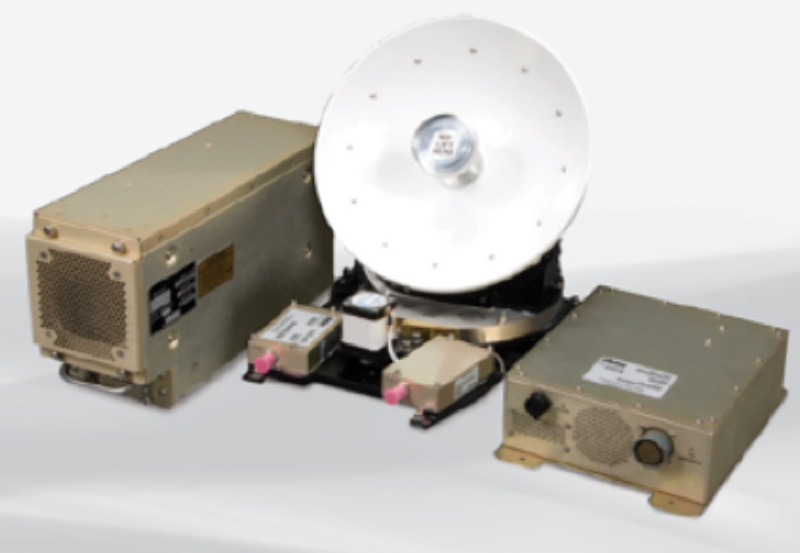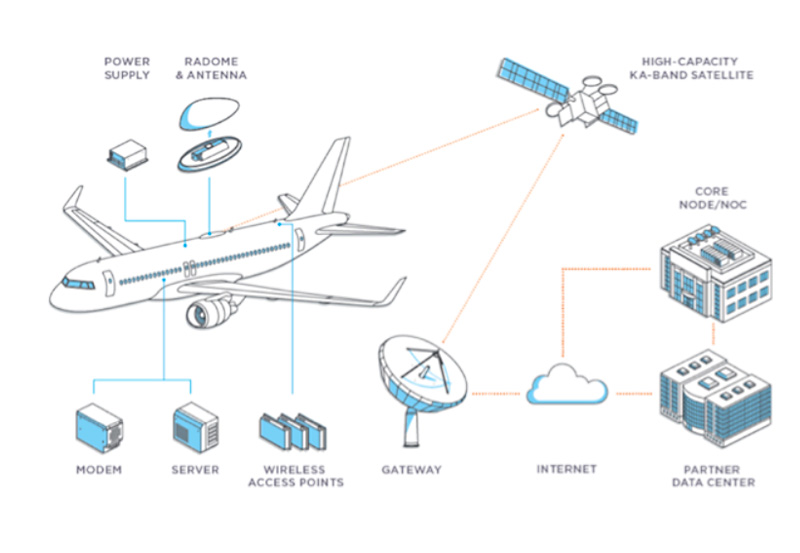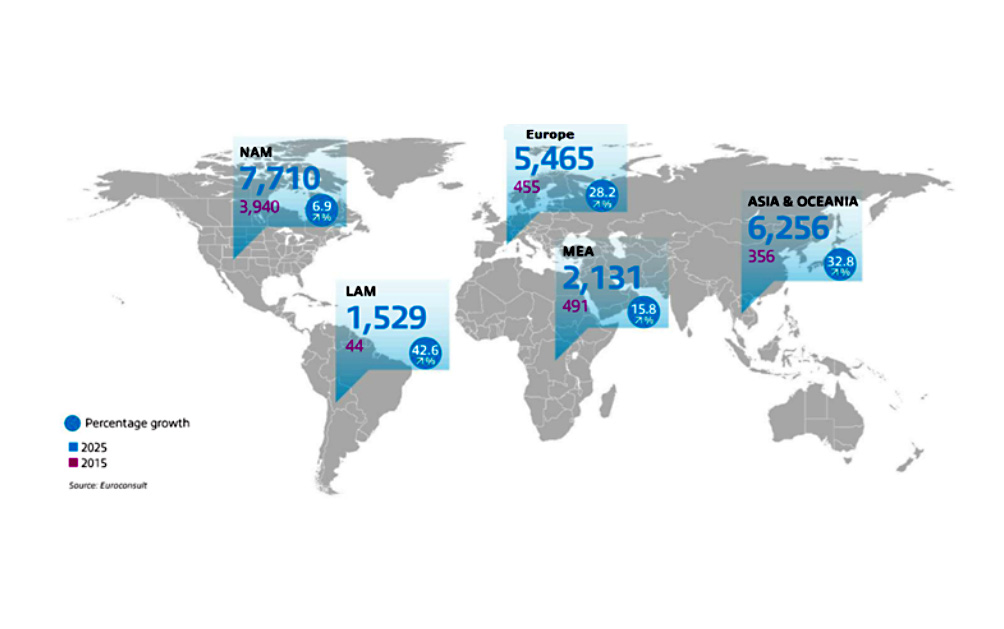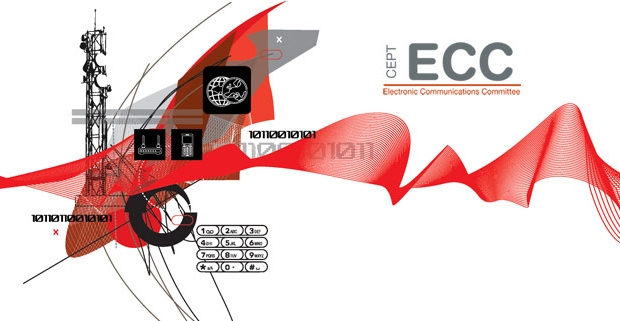ECC Newsletter October 2016
Earth Stations in motion, new opportunity in satellite communications
The ECC has an established tradition of acting proactively in supporting and introducing new technological solutions in communications - and satellite is included in those solutions.
In recent years, there has been increasing interest and demand for broadband connectivity (both voice and data) to passengers on board moving vehicles, including aircraft, ships and trains. As technologies to provide such access have developed, so too have consumers’ expectations. They desire seamless connectivity regardless of their location - whether on land, in the air or on the sea.
These systems typically use satellite links to backhaul to the wider network. The satellite components of the systems are known as Earth Stations on Mobile Platforms (ESOMPs1). A separate system is used to provide connectivity directly to the on-board end users. This system can use either mobile networks or Wi-Fi.
This article explores some of the recent regulatory developments regarding ESOMPs. The on-board component on aircraft and ships used to provide mobile data to the end users is explored in the following article.

Figure1: Illustration of the ESOMPs/ESIM concept
To facilitate the take up of these new innovative services, the ECC developed a regulatory framework to allow the use of ESOMPs - transmitting in the frequency band 27.5 – 30 GHz and receiving in the band 17.3 – 20.2 GHz (the frequency band is referred to as Ka-band). It took into consideration both Geostationary Satellite Orbit (GSO) and Non-Geostationary-Satellite Orbit (NGSO) systems. This regulation enabled several satellite operators to launch commercial satellite networks that support the use of ESOMPs.
Existing Fixed Satellite Service networks in the frequency bands 3 400 – 4 800 MHz and 10.7 – 14.5 GHz (C-band and Ku-band respectively) have already been used for many years to provide telecommunication services to mobile platforms such as aircraft and ships.
As demand for broadband connectivity evolves, satellite service providers started targeting higher frequency bands: 27.5 – 30 GHz for the uplink and 17.3 – 20.2 GHz for the downlink. After all, they want to meet the market demand and the resulting need for greater broadband speed, capacity and efficiency.
Various satellite operators are already making investments in this regard, accounting for several billion euros. As a result, multiple innovative satellites and constellations are either deployed already or soon to be launched.
Recent advances in stabilised antenna technology have allowed the development of earth station antennas capable of maintaining a very stable pointing accuracy. This allows the earth station’s antenna to track the wanted satellite in orbit even when the earth station is mounted on a rapidly moving platform.
This technology - sometimes used in conjunction with spread spectrum waveforms - has allowed ESOMPs to operate in accordance with characteristics similar to those of traditional uncoordinated Fixed Satellite Service earth stations located at a specific site.
With the appropriate operational controls, easily achievable thanks to today’s technologies, the potential interference to neighbouring Fixed Satellite Service networks can be effectively managed, leading to performances similar to those from fixed earth stations.

Figure 2: VR-12 antenna placed on the aeroplane
ESOMPs to support affordable aeronautical connectivity
Aircraft represent one of the main “mobile platforms” on which ESOMPs can be installed. When combined with on-board access technology (Wi-Fi or mobile networks), ESOMPs allow passengers to have broadband connectivity over wide territories (such as oceans) where other technologies are not available.
Internet and voice connectivity are attractive services for aircraft passengers, as they allow them to connect to social media and communicate online with the same speed and quality they experience in their homes. Furthermore, this connectivity is increasingly being seen by airlines as a replacement for traditional in-seat, in-flight entertainment systems; passengers may directly stream entertainment data (such as a movie or a game) rather than rely on pre-loaded content that may need to be refreshed before the aircraft’s departure.
With the recent change to rules regarding the use of personal electronic devices on board aircraft, passengers are now expecting to use their smartphones and tablets during all phases of flight from the moment they board the aircraft to the moment they leave, including take-off and landing.
As airlines introduce ESOMPs on their fleets, they are increasingly stressing the importance of being able to use the service for gate-to-gate operations, such as:
- Updating weather maps;
- Updating electronic flight bags (manuals for the engines and all the critical systems in the aircraft, which according to the International Civil Aviation Organisation rules must be carried by the crew for emergency cases);
- Providing scheduling information to their crews;
- Providing their passengers with re-booking information and/or gate updates for connecting flights;
- Reliably transferring aircraft system data.

Figure 3: Operational scenario
ESOMPs to support affordable maritime connectivity
Requirements similar to those of an aircraft exist for passenger ships. ESOMPs are also being used to provide broadband connectivity to passengers on cruise ships and to crews on merchant vessels.
The largest passenger cruise ships can carry up to around 6000 passengers, and although not all of them would simultaneously use broadband Internet services, the overall connectivity requirements of a passenger ship may be far greater than the one of a single aircraft. For ships, as for airplanes, there is the requirement for managing the ship’s operations (for example to transmit an engine’s diagnostics or to access their corporate network) and for crew communications.
Ka-band high capacity satellites have bandwidth necessary to serve this important market.
The European regulatory framework for ESOMPs
In recent years, a number of Fixed Satellite Service networks have been launched which operate within the frequency range 17.3-30.0 GHz. These satellites typically use small spot beams, which lead to increased efficiency of spectrum usage and allow for small user terminals’ antennas. Also, the increased efficiency allows for broadband communications at costs lower than for systems available in the 10.7 – 14.5 GHz frequency band.
The ECC has adopted several decisions related to the operation of Fixed Satellite Service networks and systems within the frequency range 17.3-30.0 GHz. Studies have been carried out to identify technical and regulatory conditions required for the operation of ESOMPs in the 17.3-30.0 GHz range. Results of those studies are outlined in the ECC Report 184, and became the technical basis for the development of ECC Decision (13)01. The Decision specifies the conditions to allow the free circulation and use of ESOMPs operating within GSO satellite networks. It covers the maritime and aircraft earth stations on the territories of CEPT countries implementing that Decision.
Following the development of the GSO ESOMPs regulation, CEPT developed ECC Report 217. This includes studies carried out on the technical and regulatory requirements relating to the use of land and maritime ESOMPs operating in the 17.3-30.0 GHz band with NGSO satellite networks. The ECC Report formed the basis for developing ECC Decision (15)04, which allows for the free circulation and use of NGSO ESOMPs, including maritime earth stations.
With the deployment of new NGSO satellite constellations, ECC has recently initiated activities toward the development of relevant regulations for NGSO ESOMPs operating in the 10.7 – 14.5 GHz band.
The ECC is also reviewing its framework in order to remove unnecessary constraints (for example, the relaxation of the conditions around airfields) and to improve penetration of satellite broadband services on the market. Those modifications will enable the possibility to provide broadband connectivity to passengers on board aircrafts via the internal Wi-Fi access even when in airport aprons or taxiways.
WRC-15 paved the road for the future. With WRC-19 its story continued...
Progress made at the World Radiocommunications Conference in 2015 (WRC-15) brought a new word into the Radio Regulations, giving Earth Stations in Motion (ESIMs – the ITU term for ESOMPs) worldwide recognition. It also gave them flexibility to use existing Fixed Satellite Service satellite allocations. The work carried out at WRC-15 focussed on the bands 19.7-20.2 GHz and 29.5-30.0 GHz only.
Following a CEPT proposal, WRC-15 removed the requirement for satellite networks to be simultaneously in both the Mobile Satellite Service and Fixed Satellite Service allocations. The Resolution adopted at WRC-15 on this technology also determined those provisions needed to protect other users of the same bands (such as other satellite networks and the Fixed Service in certain countries).
It is expected that the demand for broadband communications aboard aircraft will continue to grow rapidly, leading to an increasing need for Fixed Satellite Service spectrum that can be used by Ka-band ESIMs.

Figure 4: Forecast for the number of connected commercial aircrafts covering: Europe, North America (NAM), Latin America (LAM) and Middle East & Africa (MEA). Purple colour on the map depicts expected development and blue colour – current situation. Percentage shows year after year average estimation leading to the 2025 numbers.
The conference in 2019 (WRC-19) will now look at extending the range of Fixed Satellite Service frequencies that may be used by ESIMs to the bands 17.7-19.7 GHz and 27.5 – 29.5 GHz. While CEPT has already developed a regulatory framework for ESIMs operating in these bands, the need for a fully global regulatory framework has been recognised. In this context, ECC intends to actively contribute to the ITU activities to extend its framework and reach global target.
Satellite operators see an appropriate framework for ESIMs in the Ka-band as an important step due to the much greater amount of frequencies available and relatively uncrowded orbital arc. It will assist in providing broadband connectivity to the benefit of passengers on board moving vehicles.
Stella Lyubchenko, Spectrum Expert, European Communications Office, assisted by experts involved in the activities of ECC project teams FM44 and CPG-PTB
1 ESOMPS are also known as Earth Stations in Motion (ESIMs) in the International Telecommunications Union (ITU) framework



